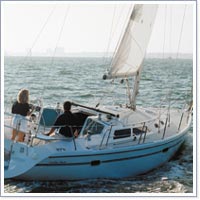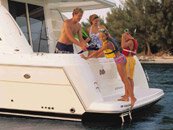Choosing the Right Boat
The sailing life offers a wealth of experiences, from cruising and racing to adventuring – enough to keep you hooked for life. Here’s how to choose the right boat to start or to continue your life under sail.
The wide-ranging nature of today’s recreational sailing has resulted in a variety (in size, type and cost) of boats. Choosing a boat that suits the way you, your friends and your family want to sail is essential. Whether you’re new to sailing or an experienced sailor, you’re probably considering a boat in one of three general categories – off-the-beach, daysailor and coastal cruiser. Each type offers particular kinds of sailing activity, from learn-to-sail to family vacations to racing, and each requires a certain level of sailing and related skills and commitment in time and money.
Off-the-beach boat
What it is: A dinghy, boardboat, or multihull (catamaran or trimaran) that can be easily cartopped or trailered and is light enough to be hand-carried (with the help of a few friends or a dolly) between the water and your car. New off-the-beach boats range from 7 to 16 or so feet in length; prices run from $700 to $3,000.
What it can do: An off-the-beach boat offers absolute ease and speed of setup (rigging the boat) and simplicity of sailing at a minimum in purchase and maintenance costs. An off-the-beach boat’s close connection with wind and water results in a gratifying immediacy of cause and effect for the sailor; shift your weight, pull on the tiller, or trim the mainsheet, and the boat responds at once. This quality makes an off-the-beach boat the best vehicle for learning to sail – and, if you choose a high-performance boat, to experience the buzz of riding waves or the thrill of planing.
Skills you’ll need: An off-the-beach boat requires more nimbleness than physical strength to sail. Some caveats: You must be able to swim and to right the boat and pull yourself back aboard if it capsizes. The degree of sailing skill you’ll need varies from none to novice (in dedicated learn-to-sail boats, such as the Escape) to intermediate (Laser, MX-Ray and other performers). Safe sailing practices, such as wearing a PFD (personal flotation device), appropriate sailing gear (a wetsuit or drysuit), and basic weather smarts (recognizing and avoiding dangerous weather) are important.
Money/time commitment: An off-the-beach boat will take a minimal bite out of your budget and leisure time. Add-ons are few and low-priced, and you can be out on the water within minutes of arriving at your water-access site.
Get this boat: If your time and money are limited, if you want to learn the basics of sailing and/or build a solid foundation of sailing skills for racing, or if quick, easy access and the sheer simplicity of sailing are what appeal to you.
Daysailor
What it is: Boats in this free-form category range from the cutting-edge to the traditional (centerboarders, keelboats, or trimarans); prices for new boats run from $3,000 to $20,000. (Tip: If you’re considering a centerboard daysailor, make stability – usually, in the form of a widebeamed hull that’s resistant to capsize – a high priority.)
What it can do: Daysails with a picnic lunch with your family (or just you solo, or with a friend); mini-adventures up a river, across the bay, or, if the weather is friendly, on an overnight camping trip aboard or in a tent.
Skills you’ll need: While a daysailor may not delivery the intimate connection with wind and water that an off-the-beach boat does, not much physical agility or muscle is needed to sail the boat. You should be an intermediate sailor – that is, you know the basics of sail trim, the points of sail, the right-of-way rules, the fundamentals of anchoring, docking, and navigation (how to read a chart, plot a course, and use aids to navigation, such as buoys), and the basics of weather. If you know some but not all of the above, it’s not difficult to learn the rest – and, if you’re like a lot of us, you’ll likely chalk up some of your best sailing stories in the process.
Money/time commitment: Purchase and maintenance costs will directly reflect the boat’s size, the quality and complexity of its equipment, and where you store it. A daysailor’s cost-to-fun ratio is outstanding; most daysailors offer a wide range of sailing experiences for a modest amount of money and time.
Get this boat: If you want a boat that keeps you and your belongings (usually) dry, has low purchase and maintenance costs, and can take you and yours farther afield. Also, if you prefer a drier, bigger, more stable boat than an off-the-beach boat in which to hone your sailing skills.
Coastal cruiser
What it is: A coastal cruiser, either a keelboat or a multihull, should include living accommodations (berths and a galley, head and dining area), auxiliary power, and the ability, via reefing systems, to get its crew safely through windy conditions. If you’re considering a coastal cruiser for you first boat, limit your choice to boats in the 22- to 30-foot size range; though larger boats are seductive, you’ll likely find yourself “overboated” until you can bring your skills up to par. Types of coastal cruiser include traditional, performance-cruising, and cruiser/racer designs; basic new-boat prices range from $17,000 to $50,000.
What it can do: We’re in the boat-as-a-sailing-home category here: daysails, coastal and short ocean passages, overnight, liveaboard, and cruising vacations, as well as entertaining at the dock.
Skills you’ll need: At a minimum, you should have intermediate-level sailing, navigation, anchoring, docking and weather skills, from which you’ll need to work toward self-sufficient seamanship. You’ll also need to develop maintenance and fix-it skills appropriate to the equipment and systems on your boat.
Money/time commitment: While the money outlay can be roughly quantified by calculating purchase, maintenance, and upgrade expenditures and berthing, haulout, and storage costs, the time commitment is more difficult to pin down. A used boat, especially if it’s more than about five years old, will require more of your (or a paid professional’s) time than a new boat. If you’re concerned about the amount of money or time you can realistically devote to a coastal cruiser, choose a smaller, simpler, newer boat rather than a bigger, more complex, older boat. On the other hand, upgrading and general tinkering can be a highly satisfying part of owning a boat – as long as your family is happy about this aspect of the experience, too.
Get this boat: If you want a boat for vacations or coastal explorations, or you want to move up to a bluewater cruiser or a flat-out racer some day, a smallish coastal cruiser is the right boat for you.
The Sailing Life and You
When you’re narrowing your choices to specific brands and models of boats, remember to ask yourself two questions: What attracts my family and me to sailing? What do we want to get out of sailing? The answers will help you choose the right style of boat in whichever category you’re looking.
To choose the sailing boat that will be right for you and your family, visit our Boat Finder tool and narrow down your choice by browsing through a list of sail boat manufacturers and brands.
By Tom Linskey
Article Appears Courtesy of SAIL Magazine
See Also:


